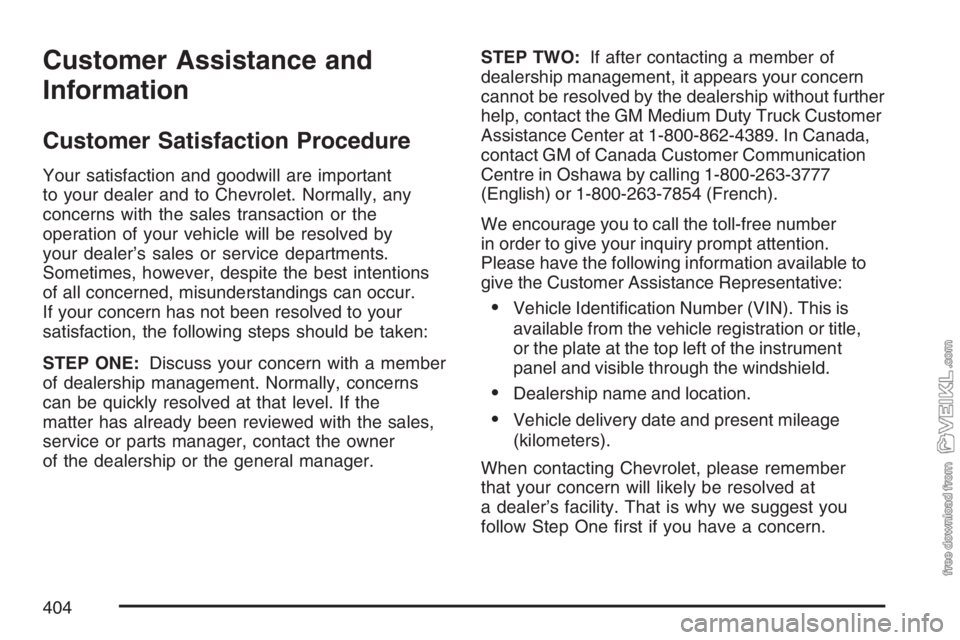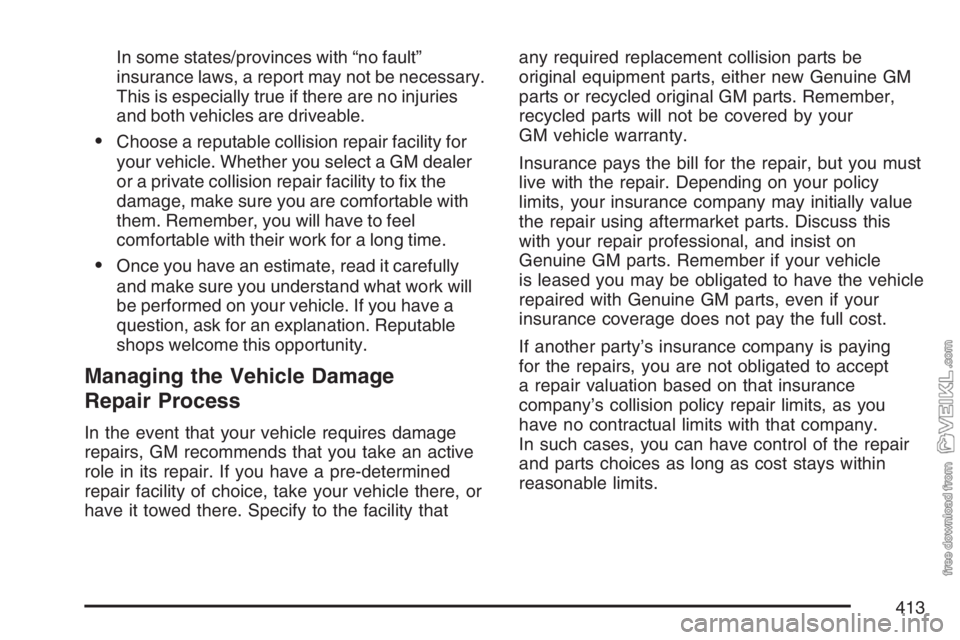ESP CHEVROLET KODIAK 2007 Owner's Manual
[x] Cancel search | Manufacturer: CHEVROLET, Model Year: 2007, Model line: KODIAK, Model: CHEVROLET KODIAK 2007Pages: 430, PDF Size: 6.06 MB
Page 404 of 430

Customer Assistance and
Information
Customer Satisfaction Procedure
Your satisfaction and goodwill are important
to your dealer and to Chevrolet. Normally, any
concerns with the sales transaction or the
operation of your vehicle will be resolved by
your dealer’s sales or service departments.
Sometimes, however, despite the best intentions
of all concerned, misunderstandings can occur.
If your concern has not been resolved to your
satisfaction, the following steps should be taken:
STEP ONE:Discuss your concern with a member
of dealership management. Normally, concerns
can be quickly resolved at that level. If the
matter has already been reviewed with the sales,
service or parts manager, contact the owner
of the dealership or the general manager.STEP TWO:If after contacting a member of
dealership management, it appears your concern
cannot be resolved by the dealership without further
help, contact the GM Medium Duty Truck Customer
Assistance Center at 1-800-862-4389. In Canada,
contact GM of Canada Customer Communication
Centre in Oshawa by calling 1-800-263-3777
(English) or 1-800-263-7854 (French).
We encourage you to call the toll-free number
in order to give your inquiry prompt attention.
Please have the following information available to
give the Customer Assistance Representative:
•Vehicle Identification Number (VIN). This is
available from the vehicle registration or title,
or the plate at the top left of the instrument
panel and visible through the windshield.
•Dealership name and location.
•Vehicle delivery date and present mileage
(kilometers).
When contacting Chevrolet, please remember
that your concern will likely be resolved at
a dealer’s facility. That is why we suggest you
follow Step One first if you have a concern.
404
Page 409 of 430

Vehicle Data Collection and
Event Data Recorders
Your vehicle, like other modern motor vehicles, has
a number of sophisticated computer systems that
monitor and control several aspects of the vehicle’s
performance. Your vehicle uses on-board vehicle
computers to monitor emission control components
to optimize fuel economy, to monitor conditions for
airbag deployment and, if so equipped, to provide
anti-lock braking and to help the driver control
the vehicle in difficult driving situations. Some
information may be stored during regular operations
to facilitate repair of detected malfunctions; other
information is stored only in a crash event by
computer systems, such as those commonly
called event data recorders (EDR).
In a crash event, computer systems, such as the
Airbag Sensing and Diagnostic Module (SDM)
in your vehicle may record information about the
condition of the vehicle and how it was operated,
such as data related to engine speed, brake
application, throttle position, vehicle speed,safety belt usage, airbag readiness, airbag
performance, and the severity of a collision.
This information has been used to improve vehicle
crash performance and may be used to improve
crash performance of future vehicles and
driving safety. Unlike the data recorders on many
airplanes, these on-board systems do not
record sounds, such as conversation of vehicle
occupants.
To read this information, special equipment is
needed and access to the vehicle or the device
that stores the data is required. GM will not access
information about a crash event or share it with
others other than:
•with the consent of the vehicle owner or,
if the vehicle is leased, with the consent of
the lessee,
•in response to an official request of police or
similar government office,
•as part of GM’s defense of litigation through
the discovery process, or
•as required by law.
409
Page 413 of 430

In some states/provinces with “no fault”
insurance laws, a report may not be necessary.
This is especially true if there are no injuries
and both vehicles are driveable.
•Choose a reputable collision repair facility for
your vehicle. Whether you select a GM dealer
or a private collision repair facility to fix the
damage, make sure you are comfortable with
them. Remember, you will have to feel
comfortable with their work for a long time.
•Once you have an estimate, read it carefully
and make sure you understand what work will
be performed on your vehicle. If you have a
question, ask for an explanation. Reputable
shops welcome this opportunity.
Managing the Vehicle Damage
Repair Process
In the event that your vehicle requires damage
repairs, GM recommends that you take an active
role in its repair. If you have a pre-determined
repair facility of choice, take your vehicle there, or
have it towed there. Specify to the facility thatany required replacement collision parts be
original equipment parts, either new Genuine GM
parts or recycled original GM parts. Remember,
recycled parts will not be covered by your
GM vehicle warranty.
Insurance pays the bill for the repair, but you must
live with the repair. Depending on your policy
limits, your insurance company may initially value
the repair using aftermarket parts. Discuss this
with your repair professional, and insist on
Genuine GM parts. Remember if your vehicle
is leased you may be obligated to have the vehicle
repaired with Genuine GM parts, even if your
insurance coverage does not pay the full cost.
If another party’s insurance company is paying
for the repairs, you are not obligated to accept
a repair valuation based on that insurance
company’s collision policy repair limits, as you
have no contractual limits with that company.
In such cases, you can have control of the repair
and parts choices as long as cost stays within
reasonable limits.
413